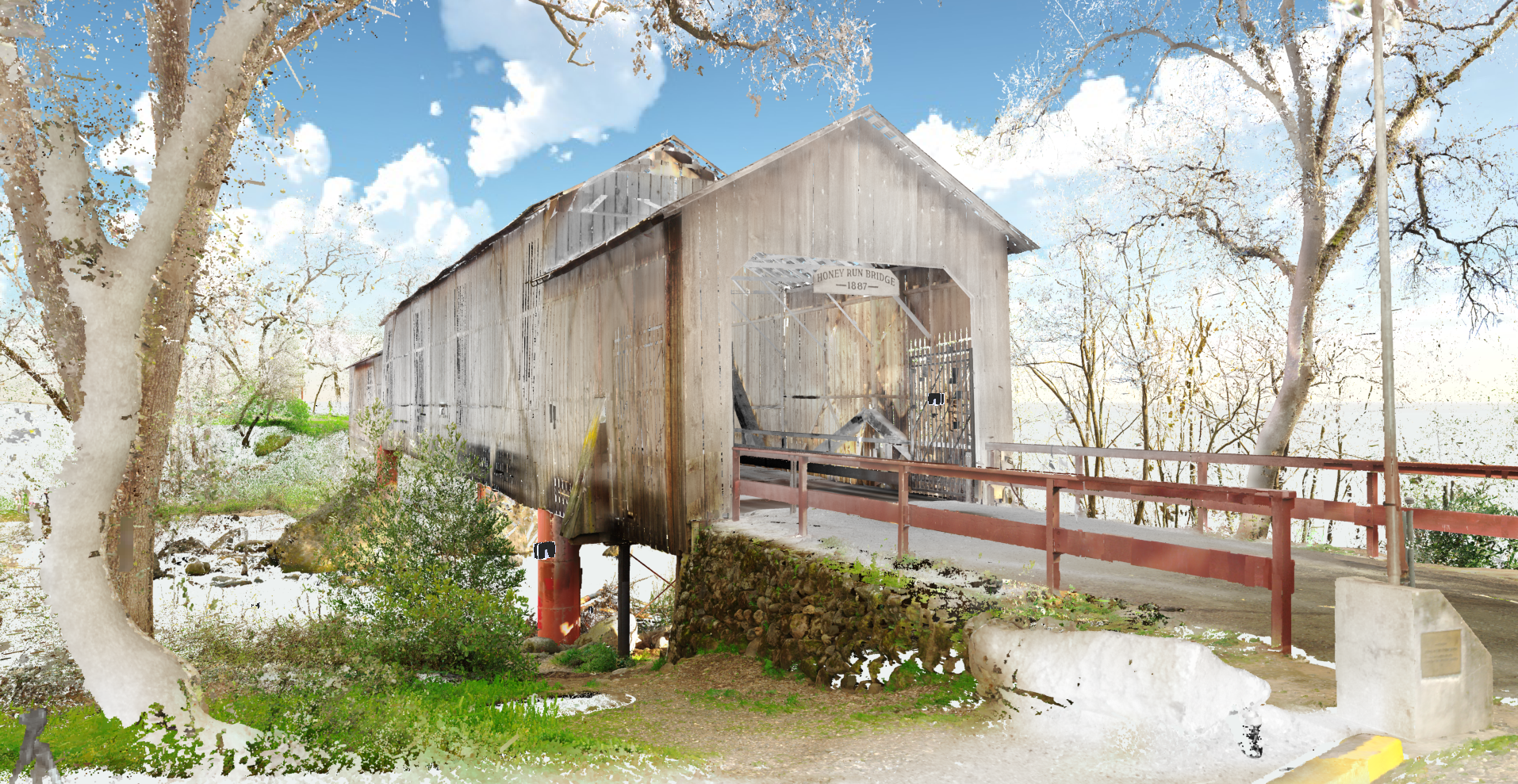A Virtual Vision of Recovery

Honey Run Covered Bridge
Few institutions in Chico date back as far as Chico State. The Honey Run Covered Bridge was one of them, opening the same year the University was founded—in 1887.
In March 2018, when students from the University’s Computer Animation and Game Development (CAGD) program set out to virtually map the 132-year-old landmark, the goal was to create an interactive animated display that would pay homage to a part of Butte County history.
When the Camp Fire decimated the town of Paradise and nearby communities in November of 2018, the beloved bridge—site to countless marriage proposals, ceremonies, photo shoots, and community events—was among the thousands of structures consumed by flames. But the fire did not destroy everything.
Months earlier, CAGD students had preserved a piece of history without ever knowing it. With a two-day rental of a $60,000 LIDAR scanner, an applied research team of five students from an upper-level CAGD class, led by instructor Frank Pereira and graduate teaching assistant Daniel Cahill, sought to collect scans of as many iconic area structures as possible. Among the first on that list was Bidwell Mansion and then the bridge, the historic wooden crossing over Butte Creek near Centerville Road.

Pressed for time, Pereira’s class tried to get the most out of its rental from the second it arrived on campus. The group scanned into the wee hours of the morning, setting up before first light to resume its work in capturing a highly detailed virtual blueprint.
The scans form a composite, 360-degree, three-dimensional image, viewable through a virtual reality headset, and the level of detail can be incredibly precise. A viewer virtually exploring the bridge would be able to pick up not just the wooden floorboards but knots and gaps in the planks as well. A look out one of the windows would provide a realistic sense of elevation over the creek. Depending on the angle from which a user viewed the bridge—there are hundreds possible—unique details and features that had previously only been preserved in memories or photos would come back to life.
The covered bridge had documentation—on paper. The Honey Run Covered Bridge Association (HRCBA), a local organization that owns the park on the west end of the structure and serves as stewards for the Butte County-owned landmark, holds its original plans and a 2016 record of inspection. When the inferno consumed the bridge, the HRBCA immediately knew it would rebuild, said President Robert Catalano.
But not until Pereira reached out and offered to show what his department was working on could Catalano truly envision just how close to the original it could be. Catalano slipped on Pereira’s VR headset, experienced the scan of the bridge, and for the briefest moment, it was as if November 8, 2018, had never happened.
“It was like I was there,” said Catalano, who lost his Paradise home in the fire. “And then your mind just goes to the opportunities after that. This is a big chance to do something for the community that represents normalcy. A couple of generations of people here know the bridge as something that’s just always been there. To rebuild it would be helping us get back to normal.
“To look in VR, and see it just as it was, you think, ‘Wow—we’re really going to do this.’”
Pereira successfully requested a University purchase of the LIDAR scanner this spring, which opens the door for students to run much more complete scans for future projects, since they won’t be under time constraints that come with renting the equipment. That means more data and more precise measurements, in a way that not only considers historical accuracy but structural improvements.
“We had no idea when we scanned that bridge what we would ultimately do with those scans,” Pereira said. “No clue. But we learned right away that this wouldn’t just apply to CAGD—this was something we could use to help. When the fire happened, it went from testing out a technology to having an application for it very quickly.”
The tech is widely used in other industries, including railroad engineering, construction, and forensics. It also has massive application in movies and video games with special effects. Cahill (Applied Computer Graphics, ’10) deployed it as the lead scan technician in recent blockbuster films like Jumanji, Guardians of the Galaxy: Vol. 2, Power Rangers, and Pirates of the Caribbean 5: Dead Men Tell No Tales. His industry expertise made him a valuable asset during the class’ brief but productive time with the rented LIDAR equipment.
Though it was another eight months until the importance of their work at the covered bridge came into focus, documenting ahead of disaster was always an obvious application for Cahill.
“There are so many iconic landmarks, and at some point, it makes sense to get them all on a hard drive, sitting and waiting, ready for an emergency,” he said. “Backups and redundancy are incredibly important. You can’t replace history that’s lost, but you can restore to a degree. It’s endless, the list of what we could protect with this technology.”
Daniel Cahill

Beyond the physical restoration possibilities, he added, is an emotional aspect that’s just as meaningful.
“You do get a sense of appreciation for the impact, when you think about all the stories people have about the bridge, what it means to them, its history here,” Cahill said. “It’s where I learned photography as a student—to come back and do this is sort of coming full circle.”
With other Chico State programs also expressing a desire to help with the bridge rebuilding, including interest from the construction management department, Catalano said he’s felt a sense of partnership from the University that gives him hope for the future of the bridge.
“This is a prime opportunity to work together with the college as part of a community,” Catalano said. “The bridge was a landmark. A new one would be a symbol of our unity.”


